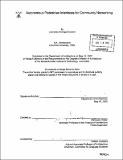Autonomous pedestrian interfaces for community networking
Author(s)
Bonanni, Leonardo Amerigo, 1977-
DownloadFull printable version (9.541Mb)
Other Contributors
Massachusetts Institute of Technology. Dept. of Architecture.
Advisor
Wellington Reiter.
Terms of use
Metadata
Show full item recordAbstract
Efforts to bridge the digital divide have concentrated on community computer centers dependent on subsidy and constant supervision. This thesis considers the design of public digital interfaces that are physically and financially autonomous while establishing an adaptable structure for community networking. These pedestrian interfaces generate income from retail and advertising already common on our streets. In turn they can provide free wireless networking and serve as community computer centers. The network of public computers is targeted to travelers along existing transportation infrastructures: streets, highways, train and bus lines. By offering services such as directions, e-mail, job-searching and web-surfing, these computer centers will provide incentive to develop digital literacy. The interfaces are climate-controlled secure street shelters. Many include a small store, an automated vending machine or a public bathroom. A flexible system of wireless input and output modules allow each interface to take on a number of public and private uses through the course of a day. The small buildings adapt continually to a user's needs to create an accessible, intuitive interface. The pedestrian interfaces are suited to current technology, and the ergonomic envelope is designed to accommodate future technologies as they become feasible.
Description
Thesis (M.Arch.)--Massachusetts Institute of Technology, Dept. of Architecture, 2003. Includes bibliographical references (leaf 51).
Date issued
2003Department
Massachusetts Institute of Technology. Department of ArchitecturePublisher
Massachusetts Institute of Technology
Keywords
Architecture.